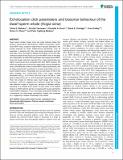Echolocation click parameters and biosonar behaviour of the dwarf sperm whale (Kogia sima)
Abstract
Dwarf sperm whales (Kogia sima) are small toothed whales that produce narrow-band high-frequency (NBHF) echolocation clicks. Such NBHF clicks, subject to high levels of acoustic absorption, are usually produced by small, shallow-diving odontocetes, such as porpoises, in keeping with their short-range echolocation and fast click rates. Here, we sought to address the problem of how the little-studied and deep-diving Kogia can hunt with NBHF clicks in the deep sea. Specifically, we tested the hypotheses that Kogia produce NBHF clicks with longer inter-click intervals (ICIs), higher directionality and higher source levels (SLs) compared with other NBHF species. We did this by deploying an autonomous deep-water vertical hydrophone array in the Bahamas, where no other NBHF species are present, and by taking opportunistic recordings of a close-range Kogia sima in a South African harbour. Parameters from on-axis clicks (n=46) in the deep revealed very narrow-band clicks (root mean squared bandwidth, BWRMS, of 3±1 kHz), with SLs of up to 197 dB re. 1 µPa peak-to-peak (μPapp) at 1 m, and a half-power beamwidth of 8.8 deg. Their ICIs (mode of 245 ms) were much longer than those of porpoises (<100 ms), suggesting an inspection range that is longer than detection ranges of single prey, perhaps to facilitate auditory streaming of a complex echo scene. On-axis clicks in the shallow harbour (n=870) had ICIs and SLs in keeping with source parameters of other NBHF cetaceans. Thus, in the deep, dwarf sperm whales use a directional, but short-range echolocation system with moderate SLs, suggesting a reliable mesopelagic prey habitat.
Citation
Malinka , C E , Tønnesen , P , Dunn , C A , Claridge , D E , Gridley , T , Elwen , S H & Teglberg Madsen , P 2021 , ' Echolocation click parameters and biosonar behaviour of the dwarf sperm whale ( Kogia sima ) ' , Journal of Experimental Biology , vol. 224 , no. 6 , jeb240689 . https://doi.org/10.1242/jeb.240689
Publication
Journal of Experimental Biology
Status
Peer reviewed
ISSN
0022-0949Type
Journal article
Description
PhD and fieldwork funding were provided by the Danmarks Grundforskningsfond (27125 to P.T.M.), the Oticon Fonden (18-0340 to C.E.M.) the Dansk Akustisk Selskab (to C.E.M.), the South Africa National Research Foundation (research career advancement fellowship to S.E.) and the Claude Leon Foundation (postdoctoral fellowship to T.G.).Collections
Items in the St Andrews Research Repository are protected by copyright, with all rights reserved, unless otherwise indicated.

